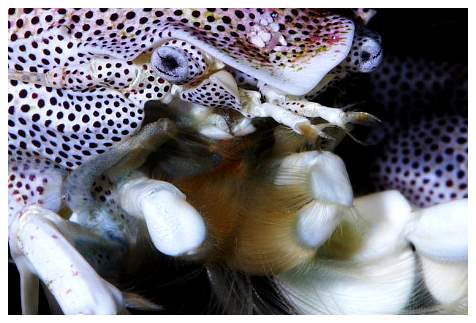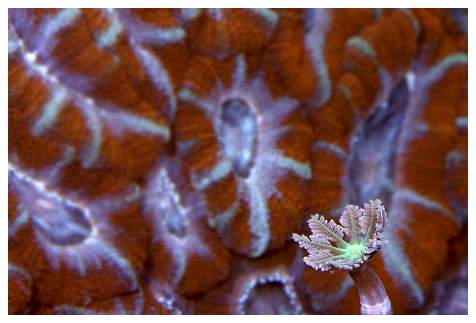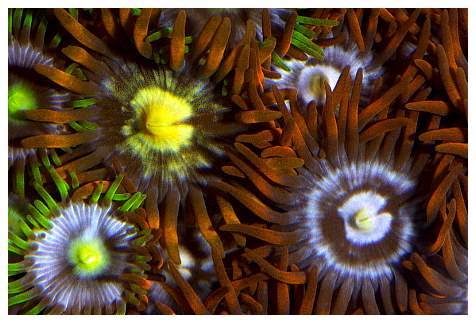|
One of the primary
things that attract people to reefkeeping is the amazing diversity
of organisms available to the average aquarist. The eye-popping
colors, patterns and details found in some aquatic species
appear so fantastic as to seem unreal. The first time I stepped
into a saltwater fish store I was awestruck - who wouldn't
be? But what's more amazing, and perhaps harder to appreciate,
is the minute detail… so tiny and intricate, it's nearly
impossible to fully comprehend the complexity with the naked
eye. A good close-up photograph shows things that you might
not be able to fully appreciate without the help of a camera.
This article will provide some tips on how to improve your
close-up photography skills so you'll be able to share your
aquarium's infinitely detailed glory with others.
 |
For those of you who have digital point-and-shoot cameras,
some of the following techniques will be slightly different
from shooting with digital single lens reflex (dslr) cameras,
although many of the tips hold true for dslr cameras, too.
Briefly, a point-and-shoot camera is one that comes with a
lens (usually a zoom lens) that is permanently attached to
the camera. A single lens reflex (slr) camera uses a variety
of interchangeable lenses, allowing the user to choose the
most effective lens for any photograph. Camera manufacturers
make a wide variety of lenses, which ultimately give the photographer
greater creative flexibility. Point-and-shoot cameras offer
ease of use and the convenience of small size and portability.
They're also much less expensive than dlsrs.
Terminology
First, let's discuss a bit of the
terminology that is important for close-up photography. The
photographic term "minimum focus distance" refers
to the point that is the shortest distance from the camera
that the lens is able to focus on. This is a key piece of
information in determining how effective a camera/lens will
be for shooting close-ups. It's also a critical piece of information
to know in order to get the best close-ups the camera is capable
of taking. Consult the camera's manual to find out exactly
what its minimum focus distance is. This distance, and the
lens' focal length, are the two most important factors to
consider when calculating how the camera will perform for
close-up photography. The focal length isn't as big a consideration
with point-and-shoots, though, because nowadays most are designed
so that the best close-ups are achieved at the widest part
of the lens. If you're looking into buying a particular point-and-shoot
camera for taking close-ups, the most important factor
is the minimum focus distance. For more tips on buying a camera,
please see my previous Reefkeeping Magazine article.
"Magnification" describes the subject's true size
compared to its size on the sensor or film. Another term that's
used a lot for this kind of photography is "macro."
In the photographic world, this term has a specific definition,
even though it's widely misused or, shall I say, used more
widely. The true definition of macro is (at least) 1:1 magnification
- that means when comparing the subject's size in real life
to its size on film, it will be the same size (or larger)
on the piece of film (or image sensor). Last of all, "depth
of field" is a term that is particularly important. Depth
of field is defined as the distance between the closest and
furthest points in the photograph that appear to be in sharp
focus. (For an overview of what an aperture is, and how it
affects the depth of field and shutter speed, please see my
previous
Reefkeeping Magazine article.)
Most of today's point-and-shoot cameras have a "macro"
mode; when the camera is put into macro mode, usually by pressing
a button on the back of the camera, the lens can focus considerably
closer than in its regular focus mode, thus allowing the best
possible close-ups. When focusing on something far away, you
merely need to take the camera back out of macro mode by pressing
the macro button once more. A fairly new feature that camera
manufacturers are designing into point-and-shoots is a "super
macro" mode. In this mode the camera can focus on something
extremely close to the lens - sometimes even objects touching
the lens. This has the potential to make for some very interesting
photographs. If you want to take a picture at the greatest
magnification your camera is capable of, common sense would
have you zoom all the way in (full telephoto) to get the most
magnification right? Wrong! Most point-and-shoot cameras get
the greatest magnification with their lens at its widest angle.
Keep that in mind if you're having trouble getting your camera
to focus properly. Another important fact to contend with
is that as the camera is moved closer to the subject, the
inherent depth of field decreases. So, to achieve good depth
of field on extreme close-ups, we're forced to use very small
apertures. Remember that bit of information when shooting
at your camera's minimum focus distance. If you're new to
photography, a picture with a very narrow depth of field can
easily be misinterpreted as out of focus.
Focus
Focusing is problematic in all types
of aquarium photography. Close-up shots present their own
challenges to an autofocus system, but when a layer of glass
or acrylic, some water and a few hundred tiny particles are
added between the lens and the subject, it's a very difficult
situation indeed! So don't be too hard on your camera - the
odds are stacked against it! Luckily, a work-around is available
that will help - even with the toughest subjects. In aquarium
photography most focus problems arise from dealing with subjects
that lack adequate contrast and texture, and from introducing
the added confusion of layers of acrylic, water and floating
particles. The work-around is to focus on something that has
a lot of contrast (and texture) first. Find something that
has good contrast and texture that's the same distance from
the lens as your intended subject and press the shutter release
button half way down to activate the autofocus. Once the camera
has the focus locked, recompose the shot -- just make sure
to keep the button pressed half way down so the lens retains
that focus point. When the picture is framed back up on your
intended subject, press the button the rest of the way down
to take the picture. It takes a little practice, but the results
are worth the extra effort. This works well for fast-moving
kids, too. Another important tip is to always shoot into the
tank perpendicular to the glass or acrylic, to minimize distortion
from the tank's material. This distortion can usually be seen
in the LCD viewer before the picture is taken, so watch closely
for it and make small adjustments in the camera's position
to get the shot just right.
Some point-and-shoot cameras can be focused manually, usually
through some type of magnification feature on the LCD. My
experience has been that this feature is usually less than
ideal for close-ups, but still worth experimenting with if
the camera has the capability.
Depth of Field
If you're a beginning photographer,
one of your first questions will likely be, "What settings
do I use to get the best close-ups?" Because so many
variables are specific to each photograph and photographer,
more information is required to make the best recommendation.
In other words, there is no simple, one-size-fits-all group
of settings. When determining what settings to use, the first
thing to consider is depth
of field. How much depth of field do you want? Try to
train yourself to visualize the image after it's taken. If
you can picture in your mind how you want the image to look,
then you can choose the settings that will get what you're
after… as long as the depth of field concept is understood.
This photo shows a very narrow depth of field:
 |
The goal of this shot was to make the single Clavularia
polyp in the frame's bottom right stand out by blurring the
Acanthastrea background. To achieve that effect I needed
a very small depth of field. The aperture setting was approximately
f4.
This is an example of an image for which I wanted a large
depth of field:
On this shot I used a very small aperture (f8), because I
wanted the entire Echinophylia and pipefish to be in
focus.
Shutter Speeds
I like to use aperture priority exposure
mode for close-up photography. The reason is that good depth
of field is usually the most challenging thing to achieve
in close-up photography. The aperture setting is the factor
that determines how much depth of field you'll end up with.
When the camera is set to aperture priority, the camera figures
out what the correct shutter speed will be for the best shot.
Even though the camera figures out the shutter speed, you
still need to be aware of it because the shutter speed determines
whether or not a tripod is needed or if moving subjects will
appear blurry. If you've decided a lot of depth of field is
not needed and the subject is stationary, you might be able
to get a fast enough shutter speed to allow taking the picture
by holding the camera in your hands, as opposed to using a
tripod. Here's a general rule of thumb regarding shutter speeds
and handholding the camera: sharp results are achieved if
the shutter speed is at least 1/focal length. For example,
if you have a 100mm lens (or a zoom lens zoomed to a 100mm
focal length), a shutter speed of at least 1/100th
of a second is needed. Familiarize yourself with your camera
and where to find the shutter speed (and aperture) information
when the picture is displayed in playback mode, and use this
rule of thumb to determine if a tripod is needed. Remember,
too, that as the camera zooms further in, camera shake becomes
more pronounced. More than likely, a tripod will result in
sharper pictures, even when using fast shutter speeds. With
slow shutter speeds a tripod is a must. Another reason
to use a tripod is that it gives you time to carefully inspect
the composition so distracting elements can be removed from
the frame, the horizon can be leveled (when applicable), and
the subject can be placed in the best possible position. Most
cameras come with a self-timer feature that provides a delay
between the time the shutter release button is pressed and
when the picture is actually taken. Using the self-timer is
another way to get sharper pictures because we inevitably
jiggle the camera slightly when pressing the button, and even
the slightest jiggle is enough to affect sharpness at slower
speeds.
Accessories
Some accessories are available that
will improve your camera's close-up performance. The good
news is that, for the most part, they won't break the bank,
either. The most common and least expensive is a close-up
filter set; they come with three filters in different magnifications
(usually +1, +2 and +4). These filters increase magnification
by shortening the minimum focus distance of the camera's lens.
Simply put, the closer the camera is to the subject, the greater
its magnification. These filters screw onto the threads on
the front element of the lens and can be used individually
or stacked together for maximum magnification. A small step
up from the filter sets, in terms of optical quality and cost,
are multi-element close-up filters. Many manufacturers make
quality close-up filters (B+W, Canon, Nikon, Tiffen, etc.).
You've probably seen super macro close-up filters in the 10x
range. Yes, these will greatly increase the magnification.
However, they shorten the minimum focus distance to such a
great extent that depth of field is massively reduced. To
get even a tiny amount of depth of field, the smallest aperture
your camera is capable of will need to be used, which in turn
means long shutter speeds will also need to be used. Additionally,
a tripod will be necessary, and you'll be limited to subjects
that are stationary or moving very slowly. Another commonly
available accessory is the telephoto adaptor. These adaptors
increase the lens' focal length and are good for bringing
faraway subjects closer, but they have limited use in close-up
photography because they also increase the minimum focus distance.
Consult your camera's documentation to determine if your camera
requires an adaptor to use filters, and be aware that certain
low-end point-and-shoot cameras don't have filter threads,
so they can't accommodate an adapter.
Flash Photography
Flash use in aquarium photography
presents an opportunity, but it also has drawbacks. The opportunity
arises from the introduction of a large amount of light. When
a flash is used effectively, the results can be stunning.
Photography is about compromise… the photographer always
has to determine where the best compromise is between depth
of field and a shutter speed that is fast enough to freeze
movement. There is rarely enough light for our needs - even
in the most brightly-lit tanks. We can increase the ISO to
get a faster shutter speed, but the higher the ISO, the grainier
the picture will be. I always try to use the lowest ISO setting
possible to maximize the picture's quality. A more detailed
explanation of ISO can be found in this
article. Adding a burst of light from a flash allows the
photographer to choose much smaller apertures for much greater
depth of field, or to choose much faster shutter speeds -
or both; that is the beauty of the flash! For this close-up
of zoanthids (below) I wanted a lot of depth of field, but
I also needed to use a fairly fast shutter speed because I
was shooting handheld. In manual exposure mode an aperture
of f8 and a shutter speed of 1/90 were used, and the flash
was fired.
 |
In manual exposure mode both the shutter speed and aperture
are set by the user, and if a flash is used, it becomes the
main light source. In most cases the foreground subject will
be well-lit and the background will be darker when the subject
is a significant distance away from the background. If the
subject and the background are close to each other, the whole
scene will be fairly evenly-lit. If aperture or shutter speed
priority is used, the flash will act as a fill light, supplementing
the light that's already present. This technique can result
in a very natural appearance when done correctly; however,
because the flash is only a fill light, the shutter speed
will be the same as without the flash. This technique is good
for subjects that aren't moving much and/or those that don't
require a lot of depth of field. It's a particularly effective
technique for filling-in shadowy areas and is well-suited
to situations encountered outdoors. Generally speaking, though,
manual exposure mode is more useful for aquarium close-ups
because it gives you the opportunity to use fast shutter speeds
and small apertures.
Exposure Compensation
You may find that your pictures are
being over (or under) exposed when using a flash. Don't worry
- that beast can be tamed! Consult the camera's manual on
how to set flash exposure compensation - usually its icon
is a lightning bolt with a tiny plus/minus symbol. If the
picture is too bright, negative exposure compensation should
be set. It's best to experiment to determine just the right
amount of compensation, but don't worry if your first picture
comes out too bright; setting negative compensation will reduce
the flash output and get that picture looking good. The same
goes for situations where the picture is too dark. Exposure
compensation is something to familiarize yourself with even
when not using a flash. Aquarium photography frequently requires
compensation because of the strong light source coming from
directly above the subject; this creates a scene that has
a lot of contrast (very dark and very bright areas). A couple
of warnings about using a flash for aquarium pictures: to
avoid getting the flash's reflection in the picture, aim the
camera slightly downward. Also, certain subjects look unnatural
when they're lit with a flash. Most Acropora species
and many zoanthids, for example, will turn dull colors, so
it's usually best to avoid using a flash with them.
The arrival of digital cameras is the greatest thing to happen
to photography in a long time. We can practice to our heart's
content and not have to worry about film and developing costs,
and we can see right away if the picture came out the way
we wanted it to. So practice! Take some of the suggestions
in this article and use them, and then study the results.
And post your pictures in the Photography
Forum to get help, or just to show off.
|

